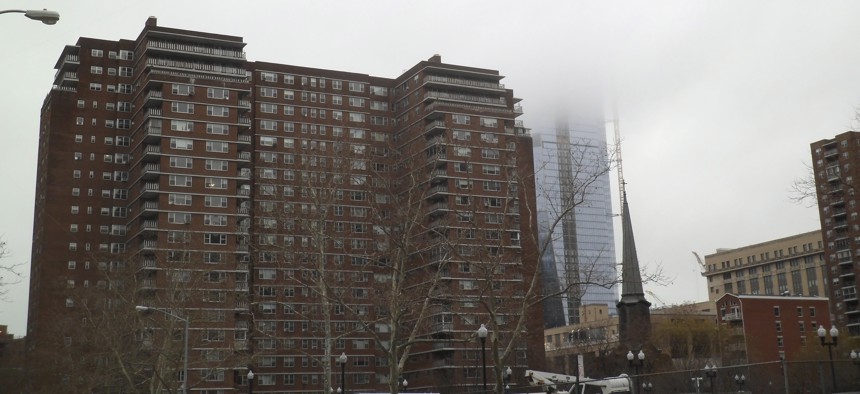Opinion
Opinion: New York needs more housing. There's a real solution on the horizon
Rather than just relying on private developers, New York state can set up a Social Housing Development Authority to build affordable housing itself.

The Penn South housing development in Chelsea is one of many examples of social housing in New York City. Richard Levine/Corbis via Getty Images
By now you know the drill: we’re in a housing crisis. Housing costs have spiked by 68% over the last decade. The high cost of living has created an exodus of taxpayers and mushroomed the costs of managing homelessness. With out-of-control housing costs, we are facing a point of no return where working families will find the city inhospitable, and the economy and culture of the city will lose its lifeblood.
City and state leaders recognize this problem. Last year, Gov. Kathy Hochul proposed a sweeping Housing Compact in an attempt to expand housing availability across the state. Unfortunately, the state has not been able to accomplish those ambitious housing goals, but we shouldn't give up. Instead of just relying on private developers and wasteful tax exemptions like 421-a, we can look to the most fiscally responsible and effective solution: a Social Housing Development Authority.
Assembly Member Emily Gallagher and state Sen. Cordell Cleare are about to introduce a bill to create a new Social Housing Development Authority for New York state. “After a half century of subsidizing developer profits, it's clear that the private sector is incapable of producing permanently affordable housing at the scale necessary to meet this crisis. Drawing on our vibrant legacy, the Social Housing Development Authority can create and preserve beautiful, sustainable and democratically-controlled homes for New Yorkers, built with union labor,” the lawmakers said.
The status quo is egregiously inefficient. Our current system relies largely on private developers, who are in fact building housing but overwhelmingly for the top of the market. According to the city’s most recent housing survey, New York City added around 175,000 homes between 2017 and 2021, but developers overbuilt for the rich so much that they ended up with an over 12% vacancy rate for high-rent apartments (over $2,300/month), compared to a less than 1% vacancy rate for low-rent ones (under $1,500/month).

Recent assessments of 421-a demonstrate that the return on cost for developer tax breaks is wildly out of proportion with the number of affordable units generated and their depth of affordability. Since 1990, program costs have exploded by over 1200%, while the number of affordable units increased by just 540%. Instead of just incentivizing for-profit private developers to build the housing we need, New York can instead build housing itself – which is exactly what the Social Housing Development Authority will do.
Ultimately, it is more efficient to have one authority oversee all of the pieces of housing policy – acquisition, financing, zoning, construction and more – than to have a mishmash of federal, state, local and private actors all making things more complicated, expensive and politically impossible for all players involved. Having a single authority in charge of building the housing we need would allow the state to wield economies of scale, issue bonds that could attract union pension investors and override exclusionary zoning. Simply put, this authority could develop a range of social housing from financing co-ops to building public housing outright.
Social housing has three core features: decommodification, social equality and resident control. While this may sound idealistic, New York already has a lot of it – the most in the country, in fact. Examples include some of the most well known and successful housing complexes in the city, including Co-op City in the East Bronx and Penn South in Chelsea. The Mitchell-Lama Program, passed into law in 1955, helped develop thousands of co-op and rental units that are now anchor institutions in their local contexts: 1199 Plaza along the Harlem River in Manhattan, Manhattan Plaza in Midtown, Dayton Towers in Rockaway Beach and Cadman Towers in Brooklyn Heights.
New York once had a successful social housing development authority – the Urban Development Corporation. Between 1968 and 1975, it helped develop over 33,000 homes, many of which were social housing, including Marcus Garvey Park Village, Schomburg Plaza and all of Roosevelt Island. Some of the busiest eras for construction of mass housing in New York were state-led social housing booms. We have more social housing than anywhere in the country (9% of total housing stock), but it is still nowhere near enough, especially compared to other cities like Singapore where the number is more like 72%. That’s why other cities and states are experimenting with their own measures: Seattle recently passed a ballot resolution creating a Social Housing Authority, and Rhode Island and Hawaii are getting closer to creating their own.
New York is the densest city in the U.S. and one of the most diverse, in large part because of its social housing; it’s time to lead the way again. New Yorkers of all stripes will benefit if the state Legislature passes the forthcoming social housing development authority bill.
Avi and Andrew are researchers and writers based in New York City. They are graduates of Hunter College’s department of Urban Policy & Planning.
NEXT STORY: Opinion: Why Somos needs to stay in Puerto Rico

